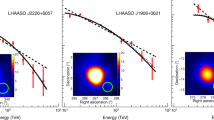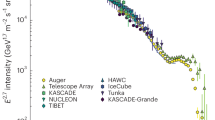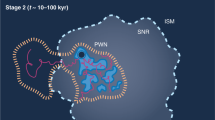Abstract
Golden et al.1 have demonstrated that the measured ratio of the flux of antiprotons to protons (p̄/p ratio) is significantly greater than expected from the commonly adopted ‘leaky box’ model of cosmic ray propagation, a model in which the p̄'s are secondaries generated by the interaction of cosmic rays with the interstellar medium (ISM) in the Galaxy. At the energy at which measurements were made (kinetic energy≃8 GeV), disturbing effects due to interplanetary modulation are negligible and there is now general agreement2–5 that the excess is a factor of 3 at least (an earlier calculation6 of the expected p̄/p which gave a result near to observation has been shown to be incorrect2–5). Bogolomov7 found a similar but statistically less compelling enhancement at somewhat lower energies. A prominent characteristic of the p̄/p ratio for galactic secondaries is a rapid fall with decreasing energy, below≃5 GeV, due to kinematic factors. It was therefore remarkable that Buffington et al.8 recently reported a ratio only a factor of 2.5 smaller at a very low kinetic energy (average≃0.2 GeV). This result, if correct, necessitates serious consideration of more exotic explanations. An important feature at these very low energies is the modulation of the flux by the interplanetary field and we have now examined this facet. We describe an improved calculation of the energy spectrum of p̄ expected for the standard leaky box model and show that even the enhanced secondary p̄ production in the ‘closed Galaxy’ model of Peters and Westergaard9 fails by a wide margin to reproduce the high observed flux at low energies. A more radical departure from conventional thinking is to regard the observed p̄s as primaries; a universal baryon-symmetric model and a black hole evaporation model are considered.
This is a preview of subscription content, access via your institution
Access options
Subscribe to this journal
Receive 51 print issues and online access
$199.00 per year
only $3.90 per issue
Buy this article
- Purchase on Springer Link
- Instant access to full article PDF
Prices may be subject to local taxes which are calculated during checkout
Similar content being viewed by others
References
Golden, R. L. et al. Phys. Rev. Lett. 43, 1196 (1979).
Gaisser, T. K. & Maurer, R. H. Phys. Rev. Lett. 30, 1264 (1973).
Szabelski, J., Wdowczyk, J. & Wolfendale, A. W. Nature 285, 386 (1981).
Stephens, S. A. Nature 289, 267 (1981).
Tan, L. C. & Ng, L. K. J. Phys. G7, 123 (1981).
Badhwar, G. D. et al. Astrophys. Space Sci. 37, 283 (1975).
Bogomolov, E. A. et al. Proc. Int. Cosmic Ray Conf., Kyoto, 1, 330 (1979).
Buffington, A., Schindler, S. M. & Pennypacker, C. R. Astrophys. J. (in the press).
Peters, B. & Westergaard, N. J. Astrophys. Space Sci. 48, 21 (1977).
Goldstein, M. L., Fisk, L. A. & Ramaty, R. Phys. Rev. Lett. 25, 832 (1970).
Urch, I. H. & Gleeson, L. J. Astrophys. Space Sci. 20, 177 (1973).
Jokipii, J. R. & Kopriva, D. A. Astrophys. J. 234, 381 (1979).
Evenson, P. et al. EFI Preprint 81–14, Pap. SH 4.2–3; Proc. int. Cosmic Ray Conf., Paris (in the press).
Strong, A. W. & Wolfendale, A. W. J. Phys. G4, 1793 (1978).
Giler, M. et al. J. Phys. A10, 843 (1977).
Stecker, F. W. NASA Tech. Mem. 82083 (1981).
Strong, A. W., Wolfendale, A. W. & Worrall, D. M. Mon. Not. R. astr. Soc. 175, 23 (1976).
Wdowczyk, J. & Wolfendale, A. W. Nature 281, 356 (1979).
Khazan, Y. M. & Ptuskin, V. S. Proc. int. Cosmic Ray Conf., Plovdiv, 2, 4 (1977).
Said, S. S. et al. Proc. Int. Cosmic Ray Conf., Paris (in the press).
Hawking, S. W. Nature 248, 30 (1974).
Page, D. F. & Hawking, S. W. Astrophys. J. 206, 1 (1976).
Carr, B. J. Astrophys. J. 206, 8 (1976).
Carter, B. et al. Astr. Astrophys. 52, 427 (1976).
Page, D. N. Phys. Rev. D13, 198 (1976).
Page, D. N. Phys. Rev. D16, 2402 (1977).
Carr, B. J. Astrophys J. 201, 1 (1975).
Giler, M., Wdowczyk, J. & Wolfendale, A. W. Astr. Astrophys. 84, 44 (1980).
Strong, A. W. & Wolfendale, A. W. J. Phys. G4, 1793 (1978).
Author information
Authors and Affiliations
Rights and permissions
About this article
Cite this article
Kiraly, P., Szabelski, J., Wdowczyk, J. et al. Antiprotons in the cosmic radiation. Nature 293, 120–122 (1981). https://doi.org/10.1038/293120a0
Received:
Accepted:
Issue Date:
DOI: https://doi.org/10.1038/293120a0
This article is cited by
-
High precision cosmic ray physics with AMS-02 on the International Space Station
La Rivista del Nuovo Cimento (2020)
-
Cosmic Ray Electrons and Protons, and Their Antiparticles
Brazilian Journal of Physics (2014)
-
Very high and ultra-high-energy gamma-rays from giant molecular clouds
Astrophysics and Space Science (1991)
-
MASS-SAT: Matter-Antimatter Space Spectrometer on Satellite
Il Nuovo Cimento B Series 11 (1990)
-
Mass-height relation for antimatter meteors
Earth, Moon, and Planets (1990)
Comments
By submitting a comment you agree to abide by our Terms and Community Guidelines. If you find something abusive or that does not comply with our terms or guidelines please flag it as inappropriate.



